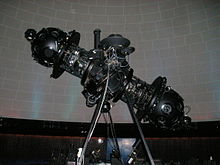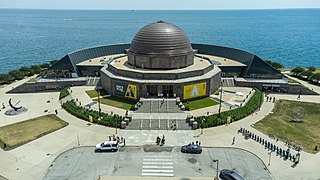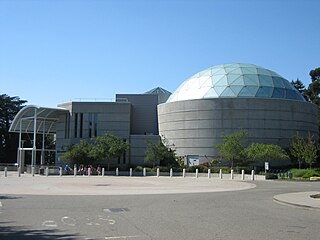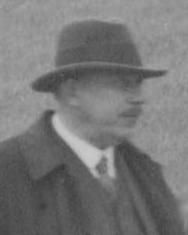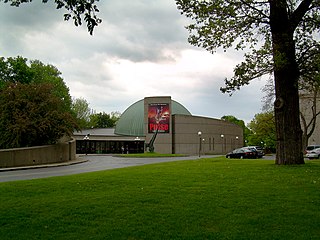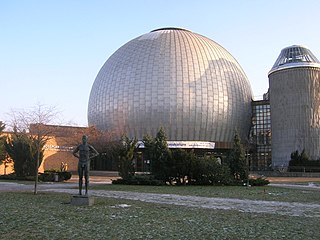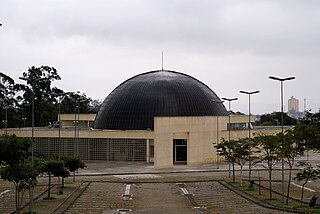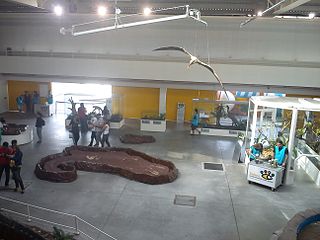| Planetarium | Zeiss Projector Model | Acquisition Date | End Date | Remarks |
|---|
| Sijthoff planetarium [ nl ], The Hague, Netherlands | Mark I | 1934 | 1976 | Destroyed by fire, although the projector has been restored. [7] |
| Silesian Planetarium, Chorzów, Poland | Mark II | 1955 | 2018 | Silesian Planetarium, the oldest Mark II still in use worldwide, the oldest and biggest planetarium in Poland. Retired in July 2018, will be reopened after upgrade in mid 2020. |
| Tycho Brahe Planetarium, Copenhagen, Denmark | Starmaster | 1989 | 2012 | The only experienced operator in Denmark retired in 2012. Jesper H. |
| Adler Planetarium, Chicago, Illinois, USA | Mark II/III | 1930 | 1969 | Projector was converted from Mark II to Mark III from 1959 to 1961 [8] [9] [10] |
| Mark VI | 1969 | 2011 | Replaced with "Digital Starball" system from Global Immersion Ltd. |
| Planetario Luis Enrique Erro, Mexico City, Mexico | Mark IV | 1964 | 2006 | It was the first planetarium in Mexico opened to general public and it is also one of the oldest in Latin America. [11] |
| Planetario Simon Bolivar, Maracaibo, Venezuela | Starmaster | 1968 | Present | It was the second planetarium in Venezuela. |
| SDSK Budapest Planetarium [ hu ], Budapest, Hungary | Mark VI | 1969 | 2017 | The planetarium closed indefinitely in 2017 due to rain damage. |
| Buhl Planetarium, Pittsburgh, Pennsylvania, USA | Mark II | 1939 | 1994 | Now on exhibit (but not in operation) at the Carnegie Science Center. |
| Ukraine. Kyiv planetarium | Mark IV | 1988 | Present | The dome is the second largest in Europe with a screen area of 830 m² |
| Bangkok Planetarium, Bangkok, Thailand | Mark IV | 1964 | 2016 | Replaced by an Evans & Sutherland Digistar 5. The projector is still inside the planetarium but not in operation. [12] |
| Denki kagakukan [ ja ], Osaka, Japan | Mark II (No.23) | 1937 | 1989 | First Planetarium in Japan
Preserved at Osaka Science Museum. |
| Tonichi Tenmonkan [ ja ], Tokyo, Japan | Mark II (No.26) | 1938 | 25 May 1945 | Destroyed by Bombing of Tokyo |
| Gotoh Planetarium [ ja ], Tokyo, Japan | Mark IV(No.1) | 1957 | 2001 | |
| Akashi Municipal Planetarium [ ja ], Akashi, Japan | Universal(UPP)23/3 | 1960 | Present | The oldest projector which is operating in Japan. |
| Nagoya City Science Museum, Nagoya, Japan | Mark IV | 1962 | 2010 | Closed for renovation in August 2010 |
| Mark IX | 2011 | Present | Re-opened in March 2011 [13] [14] |
| Fernbank Planetarium, Atlanta, Georgia, USA | Mark V | 1967/8? | Present | [15] |
| Hamburg Planetarium, Hamburg, Germany | Mark II | 1925 | 1957 | Projector was acquired by the City of Hamburg in 1925, the planetarium was opened to the public in 1930. |
| Mark IV | 1957 | 1983 | |
| Mark VI | 1983 | 2003 | |
| Mark IX | 2006 | Present | |
| Hayden Planetarium, New York, New York, USA | Mark II | 1935 | 1960 | [16] |
| Mark IV | 1960 | 1973 |
| Mark VI | 1973 | 1997 |
| Mark IX | 1999 | Present |
| Humboldt Planetarium [ es ], Caracas, Venezuela | Mark III (modified) | 1950 | Present | This planetarium is the oldest in Latin America. [17] [18] |
| Johannesburg Planetarium, Johannesburg, South Africa | Mark III (upgraded from Mark II) | 1960 | Present | Acquired from the city of Hamburg and upgraded to Mark III prior to installation. [19] |
| Manitoba Museum, Winnipeg, Manitoba, Canada | Mark Vs | 1967 | Present | [20] |
| Galileo Galilei planetarium, Buenos Aires, Argentina | Mark V | 1967 | 2011 | Replaced by MEGASTAR II A [21] |
| Morehead Planetarium, Chapel Hill, North Carolina, USA | Mark II | 1949 | 1969 | [22] |
| Mark VI | 1969 | 6 May 2011 |
| Planetarium of Tripoli, Tripoli, Libya | Spacemaster | 1980 | 2007 | not in operate but Still in the building |
| James S. McDonnell Planetarium, St. Louis, Missouri, USA | Mark IX | 2001 | Present | replaced an Evans & Sutherland Digistar [23] |
| Samuel Oschin Planetarium, Griffith Observatory, Los Angeles, California, USA | Mark IV | 1964 | 2006 | |
| Mark IX | 2006 | Present | |
| Strasenburgh Planetarium, Rochester, New York, USA | Mark VI | 1968 | Present | Originally cost $240,234 – in 1968 dollars. [24] |
| Planetario de Bogotá, Bogotá, Bogotá, Colombia | Mark VI | 1969 | Present | [25] |
| Fiske Planetarium, Boulder, Colorado, USA | Mark VI | 1975 | 2012 | Replaced by an Ohira Tech MEGASTAR. [26] |
| Planetario Universidad de Santiago [ es ], Santiago, Chile | Mark VI | 1972 | Present | [27] [28] |
| Calouste Gulbenkian Planetarium [ pt ], Lisbon, Portugal | UPP 23/4 | 1965 | 2004 | [29] |
| Mark IX | 2005 | Present |
| Delafield Planetarium, Agnes Scott College, Decatur, Georgia, USA | Skymaster ZKP-3 | 2000 | Present | [30] |
| Charles Hayden Planetarium, Boston Museum of Science, Boston, MA, USA | Mark VI | 1970 | 2010 | [31] |
| Starmaster | 2011 | Present | [32] |
| Nehru Planetarium, Mumbai, India | Mark IV | 1977 | 2003 | Replaced by an Evans & Sutherland Digistar 3 [33] |
| Planetario Ulrico Hoepli, Milan, Italy | Mark IV | 1968 | Present | [34] |
| Planetario Ciudad de Rosario, Rosario, Santa Fe, Argentina | Mark IV | 1962 | Present | Projector was acquired by the City of Rosario in 1962, the planetarium was opened to the public in 1984 [35] |
| Planetarium (Belgium), Brussels, BELGIUM | Mark II | 1935 | 1966 | Planetarium was closed between 1939 and 1954. Closed again in 1966. Building and projector were destroyed in 1969. A new building with a new projector was built in 1976. [36] [37] [38] [39] |
| UPP 23/5 | 1976 | present |
| Moscow Planetarium, Moscow, Russia | Mark II | 1929 | 1976 | Details preserved at Moscow Planetarium |
| Mark VI | 1977 | 1994 | Preserved at Moscow Planetarium
Planetarium ceased work in 1994 |
| Mark IX | 2010 | Present | Projector was acquired in 2010, the planetarium was renovated and opened to the public in 2011 |
| London Planetarium, Baker Street, London, UK | Mark IV | 1958 | 1995 | Now in Science Museum collection. [40] [41] |
| Chabot Space and Science Center, Oakland, California, USA | Mark VIII | 1999 | Present | As of 2016, the Mark VIII projector unit was successfully repaired, after several years being dysfunctional. |
| Cozmix, Bruges, Belgium | ZKP 3b | 2002 | Present | [42] |
| Espaço do Conhecimento do UFMG, Belo Horizonte, Minas Gerais, Brazil | ZKP 4 | 2010 | Present | [43] |
| Dow Planetarium, Montreal, Quebec, Canada | Mark V | 1966 | 2011 | Now at exhibit at the new planetarium [44] |
| Sri Lanka Planetarium, Colombo, Sri Lanka | Mark IV | 1965 | Present | This was a gift from east Germany |
| Planetário Professor Francisco José Gomes Ribeiro (Colégio Estadual do Paraná), Curitiba, Paraná, Brazil | ZKP 1 | 1978 | Present | |
| Planetário da Fundação Espaço Cultural, João Pessoa, Paraíba, Brazil | Spacemaster | 1982 | Present | [45] |
| Birla Planetarium, Kolkata, India | Universal | 1962 | | [46] |
| Sardar Patel Planetarium, Vadodara, India | Spacemaster | 1976 | | [46] |
| Nehru Planetarium, Mumbai, India | Universal | 1977 | | [46] |
| Sternwarte Planetarium SIRIUS, Schwanden near Sigriswil, Switzerland | ZKP 2 | 2000 | 2014 | |
| ZKP 4 | 2014 | Present | |


